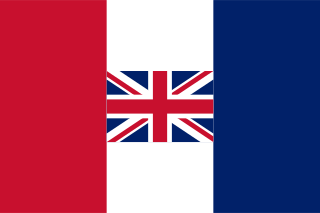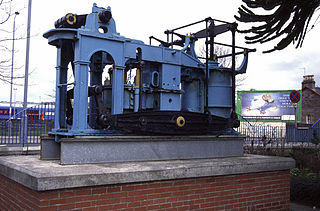Related Research Articles

A steamship, often referred to as a steamer, is a type of steam-powered vessel, typically ocean-faring and seaworthy, that is propelled by one or more steam engines that typically move (turn) propellers or paddlewheels. The first steamships came into practical usage during the early 1800s; however, there were exceptions that came before. Steamships usually use the prefix designations of "PS" for paddle steamer or "SS" for screw steamer. As paddle steamers became less common, "SS" is assumed by many to stand for "steamship". Ships powered by internal combustion engines use a prefix such as "MV" for motor vessel, so it is not correct to use "SS" for most modern vessels.

The Fairfield Shipbuilding and Engineering Company, Limited was a Scottish shipbuilding company in the Govan area on the Clyde in Glasgow. Fairfields, as it is often known, was a major warship builder, turning out many vessels for the Royal Navy and other navies through the First World War and the Second World War. It also built many transatlantic liners, including record breaking ships for the Cunard Line and Canadian Pacific, such as the Blue Riband-winning sisters RMS Campania and RMS Lucania. At the other end of the scale Fairfields built fast cross-channel mail steamers and ferries for locations around the world. These included ships for the Bosporus crossing in Istanbul and some of the early ships used by Thomas Cook for developing tourism on the River Nile.

The Pacific Mail Steamship Company was founded April 18, 1848, as a joint stock company under the laws of the State of New York by a group of New York City merchants. Incorporators included William H. Aspinwall, Edwin Bartlett, Henry Chauncey, Mr. Alsop, G.G. Howland and S.S. Howland.

SSCity of Glasgow of 1850 was a single-screw passenger steamship of the Inman Line, which disappeared en route from Liverpool to Philadelphia in January 1854 with 480 passengers and crew. Based on ideas pioneered by Isambard Kingdom Brunel's SS Great Britain of 1845, City of Glasgow established that Atlantic steamships could be operated profitably without government subsidy. After a refit in 1852, she was also the first Atlantic steamship to carry steerage passengers, representing a significant improvement in the conditions experienced by immigrants. In March 1854 City of Glasgow vanished at sea with no known survivors.

The Illawarra Steam Navigation Company was a shipping company that serviced the south coast of New South Wales, Australia from 1858 to the early 1950s. It was formed through the amalgamation of the General Steam Navigation Company, the Kiama Steam Navigation Company and the Shoalhaven Steam Navigation Company, each of whom serviced parts of the south coast with their respective vessels. After merging, the new company held a near monopoly in regard to shipping on the south coast, and their fleet visited every significant port between Sydney and the border of Victoria. The company transported both passengers and a range of produce, including livestock, and hence it became known as the 'Pig and Whistle Line': it was said that ships would wait an hour for a pig but not a minute for a passenger.

P Henderson & Company, also known as Paddy Henderson, was a ship owning and management company based in Glasgow, Scotland and operating to Burma. Patrick Henderson started business in Glasgow as a merchant at the age of 25 in 1834. He had three brothers. Two were merchants working for an agent in the Italian port of Leghorn; the third, George, was a sea captain with his own ship.

RMS Moldavia was a British passenger steamship of the early 20th century. She served as the Royal Navy armed merchant cruiser HMS Moldavia during World War I until sunk by an Imperial German Navy submarine in 1918.
Teutonia was a screw steamer that was built by Caird & Company, Greenock, Renfrewshire, Scotland for the Hamburg Brazilianische Packetschiffahrt Gesellschaft in 1856. It later served with the Hamburg Amerika Line before being sold to British owners in 1877 and Italian owners in 1884, serving them under the names Regina, Piemontese, Città di Savona and Mentana The ship was scrapped in 1894.

The North Coast Steam Navigation Company was a shipping company that operated in Australia, formed as the Grafton Steam Navigation Company in 1855. The company was later renamed the Clarence & Richmond River Steam Navigation Company before being renamed in December 1888 as the Clarence, Richmond & Macleay River Steam Navigation Company.

SS Lake Champlain was built in 1874 at Glasgow by the shipbuilders London & Glasgow Co. Ltd., she was launched on Christmas Day 1874 and sailed for a mere 13 years. On 13 April 1875 she departed on her maiden voyage from Liverpool to Quebec and then to Montreal. Until 1884 her regular run was between Liverpool and Quebec. On 23 November 1885, near Matane, she collided with the SS Bentholme which sank as a result. On 30 June 1886, she ran aground on the Antrim coast, but was refloated, sold, and renamed Lismore. On 8 June 1888 she was wrecked at Porto Plata in the Dominican Republic.

SS (RMS) Tynwald (II), No. 45474, was an iron paddle-steamer which served with the Isle of Man Steam Packet Company, and was the second vessel in the Company to bear the name.

Bombay Steam Navigation Company was the first Indian owned shipping company. It was founded by Ismail Hasham, a Kutchi Memon.
SS Nubia was a passenger steamer, built by John Laird Sons & Company in Birkenhead in 1854 for the Peninsular and Oriental Steam Navigation Company at a cost of £65,750. It was launched on 28 February 1854 and commenced formal service between Southampton and Alexandria on 4 September 1854. It was briefly used in the Crimean War later that year before continuing operations between Suez and Calcutta, passing through the port of Aden en route. On 5 October 1864, it encountered trouble during a cyclone in Calcutta and was driven ashore near King Oudh's palace and had to be refloated. In September 1867, Nubia rescued the passengers of Surat, which had ran aground on a reef in the Gulf of Suez.

SS Nubian was a steamer built in 1876 by Charles Mitchell & Co. of Newcastle-Upon-Tyne, England, and was operated by the Union Steamship Company of Southampton, England. A passenger and cargo steamer with a compound engine provided by Thos. Clark & Co of Newcastle-upon-Tyne, she had a top speed of 12 knots. She later was lengthened. From 1876 to 1883, she was used for Cape mail service, and from 1884 she was used for transport between Liverpool, England, Bermuda, and Baltimore, Maryland. In 1887 she steamed to Portuguese East Africa and was used in South Africa from 1888 until 1892. She was lost in the Atlantic Ocean off Lisbon, Portugal, on 20 December 1892.

SS Nubia was a passenger-cargo steamer built for the Peninsular and Oriental Steam Navigation Company by Caird & Company of Greenock, Scotland, at a cost of £100,000 and launched on 13 December 1894.
SS Aleppo was a British passenger cargo vessel, launched on 1 November 1864, measuring 292.5 feet by 38.2 feet, 2,057 gross tonnage, built in Glasgow by J & G Thomson, Govan. She made her first North Atlantic voyage from Liverpool to Halifax to New York City beginning on 15 September 1865. The Aleppo had accommodation for 46 first class and 593 third class passengers. The ship was commissioned for the British & Foreign Steam Navigation Company, Glasgow, a company established in 1855 to run the Mediterranean shipping interests of the investors of the British and North American Royal Mail Steam-Packet Company, the forerunner of the Cunard Line. In 1878 the firms were reorganised, the British & Foreign Steam Navigation Company and its ships were merged into the Cunard Steam Ship Co. Ltd., and Aleppo was transferred on 7 September 1878.

Messrs Robert Napier and Sons was a famous firm of Clyde shipbuilders and marine engineers at Govan, Glasgow founded by Robert Napier in 1826. It was moved to Govan for more space in 1841. His sons James and John were taken into partnership in 1853.

HMS Mantua was a 20th-century ocean liner and armed merchant cruiser. Launched in 1909 as a passenger ship, Mantua was outfitted as an armed merchant cruiser in 1914 and served with the Royal Navy during World War I. On a voyage to Freetown in 1918, the passengers and crew of Mantua inadvertently spread the 1918 flu pandemic to Africa.
SS Tokomaru was a British steam cargo ship built in 1893 as Westmeath by C. S. Swan & Hunter of Wallsend for a Sunderland shipowner. The steamer was sold the following year to Shaw, Savill and Albion Steamship Company, renamed Tokomaru, and converted to a refrigerated ship for their New Zealand and Australian routes. In January 1915 the ship was torpedoed and sank off Le Havre, France.
Several vessels have been named Flinders after British explorer Matthew Flinders (1774–1814), including:
References
- ↑ Daly, Martin W.; Hogan, Jane R. (2005). Images of Empire: Photographic Sources for the British in the Sudan. BRILL. p. 95. ISBN 978-90-04-14627-3.